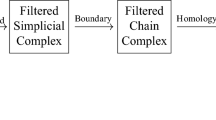Abstract
In this paper, the authors study further properties and applications of weighted homology and persistent homology. The Mayer-Vietoris sequence and generalized Bockstein spectral sequence for weighted homology are introduced. For applications, the authors show an algorithm to construct a filtration of weighted simplicial complexes from a weighted network. They also prove a theorem to calculate the mod p2 weighted persistent homology provided with some information on the mod p weighted persistent homology.
Similar content being viewed by others
References
Adcock, A., Carlsson, E., and Carlsson, G., The ring of algebraic functions on persistence bar codes, Homology, Homotopy and Applications, 18(1), 2016, 381–402.
Albert, R. and Barabási, A.-L., Statistical mechanics of complex networks, Reviews of Modern Physics, 74(1), 2002, 47–49.
Basum, S. and Parida, L., Spectral sequences, exact couples and persistent homology of filtrations, Expositions Mathematicae, 35(1), 2017, 119–132.
Bell, G., Lawson, A., Martin, J., et al., Weighted persistent homology, Involve, 12(5), 2019, 823–837.
Bendich, P., Marron, J. S., Miller, E., et al., Persistent homology analysis of brain artery trees, The Annals of Applied Statistics, 10(1), 2016, 198–218.
Boccaletti, S., Latora, V., Moreno, Y., et al., Complex networks: Structure and dynamics, Physics reports, 424(4), 2006, 175–308.
Boissonnat, J.-D. and Maria, C., Computing persistent homology with various coefficient fields in a single pass, Lecture Notes in Comput. Sci., 8737, Springer-Verlag, Heidelberg, 2014, 185–196.
Browder, W., Torsion in H-spaces, Annals of Mathematics, 74(2), 1961, 24–51.
Bubenik, P., Statistical topological data analysis using persistence landscapes, The Journal of Machine Learning Research, 16(1), 2015, 77–102.
Bubenik, P., and Kim, P. T., A statistical approach to persistent homology, Homology Homotopy and Applications, 9(2), 2007, 337–362.
Bubenik, P., and Scott, J. A., Categorification of persistent homology, Discrete & Computational Geometry, 51(3), 2014, 600–627.
Buchet, M., Chazal, F., Oudot, S. Y. and Sheehy, D. R., Efficient and robust persistent homology for measures, Computational Geometry, 58, 2016, 70–96.
Carlsson, G., Ishkhanov, T., De Silva, V. and Zomorodian, A., On the local behavior of spaces of natural images, International Journal of Computer Vision, 76(1), 2008, 1–12.
Chow, T. Y., You could have invented spectral sequences, Notices of the AMS, 53, 2006, 15–19.
Dawson, R. J. MacG., Homology of weighted simplicial complexes, Cahiers de Topologie et Géométrie Différentielle Catégoriques, 31(3), 1990, 229–243.
DeWoskin, D., Climent, J., Cruz-White, I., et al., Applications of computational homology to the analysis of treatment response in breast cancer patients, Topology and Its Applications, 157(1), 2010, 157–164.
Dłotko, P., and Wagner, H., Simplification of complexes of persistent homology computations, Homology Homotopy and Applications, 16(1), 2014, 49–63.
Doran, B., Giansiracusa, N. and David, J., A simplicial approach to effective divisors in M0, n, International Mathematics Research Notices, 2017(2), 2016, 529–565.
Edelsbrunner, H., and Morozov, D., Persistent homology: Theory and practice, European Congress of Mathematics, 31–50, Eur. Math. Soc., Zürich, 2013
González, J. L., Gunther, E. and Zhang, O., Balanced complexes and effective divisors on M0,n, Comm. Algebra, 48(6), 2020, 2662–2680.
Hilton, P. J. and Stammbach, U., A Course in Homological Algebra, Graduate Texts in Mathematics, 4, Springer-Verlag, New York, 1997.
Lubkin, S., Cohomology of Completions, North-Holland Mathematics Studies, 42, Notas de Mathematica, 71, North-Holland Publishing Company, Amsterdam, New York, Oxford, 1980.
MacLane, S., Homology, Springer Science & Business Media, Berlin, 2012.
May, P. J. and Ponto, K., More concise algebraic topology, Localization, completion, and model categories, University of Chicago Press, Chicago, 2012.
McCleary, J., A user’s guide to spectral sequences, Cambridge Studies in Advanced Mathematics, 58, Cambridge University Press, Cambridge, 2001.
Miller, E. and Sturmfels, B., Combinatorial commutative algebra, Graduate Texts in Mathematics, 227, Springer-Verlag, New York, 2005.
Munkres, J. R., Elements of Algebraic Topology, 2, Addison-Wesley, Menlo Park, 1984.
Neisendorfer, J. A., Algebraic methods in unstable homotopy theory, New Mathematical Monographs, 12, Cambridge University Press, Cambridge, 2010.
Petri, G., Scolamiero, M., Donato, I. and Vaccarino, F., Topological strata of weighted complex networks, PloS one, 8(6), 2013, e66506.
Ren, S. Q., Wu, C. Y. and Wu, J., Weighted persistent homology, Rocky Mountain Journal of Mathematics, 48(8), 2018, 2661–2687.
Romero, A., Heras, J., Rubio, J. and Sergeraert, F., Defining and computing persistent Z-homology in the general case, arXiv:1403.7086, 2014.
Stanley, R. P., Combinatorics and Commutative Algebra, Progress in Mathematics, 41, Birkhauser Boston, Inc., Boston, 1996.
Strogatz, S. H., Exploring complex networks, Nature, 410(6825), 2001, 268–276.
Zomorodian, A., The tidy set: A minimal simplicial set for computing homology of clique complexes, Computational Geometry, 43, 257–266, 2010.
Zomorodian, A. and Carlsson, G., Computing persistent homology, Discrete & Computational Geometry, 33(2), 2005, 249–274.
Author information
Authors and Affiliations
Corresponding author
Additional information
This work was supported by the Singapore Ministry of Education Research Grant (AcRF Tier 1 WBS No.R-146-000-222-112), the Postdoctoral International Exchange Program of China 2019 Project from the Office of China Postdoctoral Council, China Postdoctoral Science Foundation, the President’s Graduate Fellowship of National University of Singapore, the Natural Science Foundation of China (Nos. 11971144, 12001310), High-Level Scientific Research Foundation of Hebei Province and China Postdoctoral Science Foundation (No. 2019–2021).
Rights and permissions
About this article
Cite this article
Ren, S., Wu, C. & Wu, J. Computational Tools in Weighted Persistent Homology. Chin. Ann. Math. Ser. B 42, 237–258 (2021). https://doi.org/10.1007/s11401-021-0255-8
Received:
Published:
Issue Date:
DOI: https://doi.org/10.1007/s11401-021-0255-8




